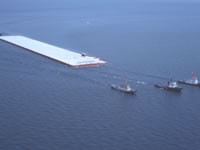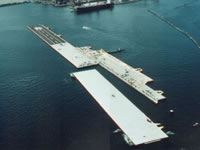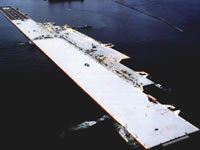| Step1:Fabrication at Shipyard | ||
 |
First of all, relatively small unit with dimensions of approximately 300m long and 60m wide, which is a maximum class as conventional ship, is fabricated at shipyard having a dry dock. Generally it is easier quality-wise and cost-wise to fabricate it at shipyard than to do it at installation site, because more effective equipment and more skilled workers specialized for such a work are available there. |
|
| Step2:Towing to Installation Site | ||
 |
As fabricated unit has a similar structure to ship, it is buoyant and able to be transported on sea. Each unit necessary to install is transported to site one by one by tugboats with strong engine. The towing is an experienced and reliable construction work used in offshore installation. | |
| Step3:Installation of Mooring Device | ||
 |
The work at the site begins with the installation of Mooring Device. The structure of the device, which is comprised of a jacket type dolphin, piles and fenders, is similar to that used commonly in oil facilities offshore, and the installation is done likewise. | |
| Step4:Mooring of Unit and Joining of Units | ||
 |
The first unit transported to the site is moored to the mooring device. The next unit transported successively is joined to the first one. Because the joining work is to be done on sea, the relative movement between two units by waves is inevitable, and the new technology is needed to be developed. Please refer to the video in Top Page or the paper for more details on this subject. | |
| Step5 | ||
 |
Repeats from Step1 to Step4 as many as required for Completion | |